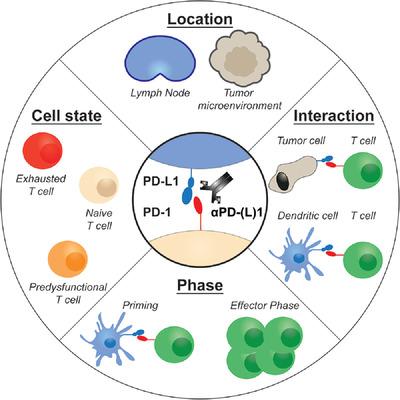当前位置:
X-MOL 学术
›
Eur. J. Immunol.
›
论文详情
Our official English website, www.x-mol.net, welcomes your
feedback! (Note: you will need to create a separate account there.)
Mechanism of action of PD-1 receptor/ligand targeted cancer immunotherapy
European Journal of Immunology ( IF 4.5 ) Pub Date : 2021-06-09 , DOI: 10.1002/eji.202048994 Jannie Borst 1 , Julia Busselaar 1 , Douwe M T Bosma 1 , Ferry Ossendorp 1
European Journal of Immunology ( IF 4.5 ) Pub Date : 2021-06-09 , DOI: 10.1002/eji.202048994 Jannie Borst 1 , Julia Busselaar 1 , Douwe M T Bosma 1 , Ferry Ossendorp 1
Affiliation

|
Immunotherapy targeting the Programmed Death (PD-1) receptor/ligand (L) “checkpoint” rapidly gains ground in the treatment of many cancer types. To increase treatment scope and efficacy, predictive biomarkers and rational selection of co-treatments are required. To meet these demands, we must understand PD-1 function in detail. We here outline recent insights into the regulation of the CD8+ T cell response by PD-1. The prevailing view has been that blockade of PD-1/ligand (L) interaction “reinvigorates” cytotoxic T lymphocytes (CTL) that were rendered dysfunctional in the tumor microenvironment (TME). However, this review stresses that tumors continuously communicate with adjacent draining lymph nodes (LNs) and that the PD-1 checkpoint also operates during T cell priming. We clarify the role of the PD-(L)1 system at the T cell/DC interface, where it regulates T cell receptor (TCR) signaling and CD28 costimulation and thus controls activation of tumor-specific T cells. We also highlight the importance of CD4+ T cell help during priming, which allows DCs to provide other costimulatory and cytokine signals required for optimal CTL differentiation and likely avoidance of a dysfunctional state. Therefore, we pose that PD-(L)1 blockade should exploit LN function and be combined with “help” signals to optimize CTL efficacy.
中文翻译:

PD-1受体/配体靶向癌症免疫治疗的作用机制
针对程序性死亡 (PD-1) 受体/配体 (L)“检查点”的免疫疗法在许多癌症类型的治疗中迅速取得进展。为了扩大治疗范围和疗效,需要预测性生物标志物和合理选择联合治疗。为了满足这些需求,我们必须详细了解PD-1的功能。我们在这里概述了对 PD-1 调节 CD8 + T 细胞反应的最新见解。普遍的观点是,阻断 PD-1/配体 (L) 相互作用可以“重振”在肿瘤微环境 (TME) 中功能失调的细胞毒性 T 淋巴细胞 (CTL)。然而,这篇综述强调肿瘤不断与邻近的引流淋巴结 (LN) 沟通,并且 PD-1 检查点也在 T 细胞启动过程中发挥作用。我们阐明了 PD-(L)1 系统在 T 细胞/DC 界面的作用,它调节 T 细胞受体 (TCR) 信号传导和 CD28 共刺激,从而控制肿瘤特异性 T 细胞的激活。我们还强调了 CD4 + T 细胞在启动过程中的重要性,这使得 DC 能够提供最佳 CTL 分化所需的其他共刺激和细胞因子信号,并可能避免功能失调状态。因此,我们认为 PD-(L)1 阻断应利用 LN 功能并与“帮助”信号相结合以优化 CTL 功效。
更新日期:2021-08-05
中文翻译:

PD-1受体/配体靶向癌症免疫治疗的作用机制
针对程序性死亡 (PD-1) 受体/配体 (L)“检查点”的免疫疗法在许多癌症类型的治疗中迅速取得进展。为了扩大治疗范围和疗效,需要预测性生物标志物和合理选择联合治疗。为了满足这些需求,我们必须详细了解PD-1的功能。我们在这里概述了对 PD-1 调节 CD8 + T 细胞反应的最新见解。普遍的观点是,阻断 PD-1/配体 (L) 相互作用可以“重振”在肿瘤微环境 (TME) 中功能失调的细胞毒性 T 淋巴细胞 (CTL)。然而,这篇综述强调肿瘤不断与邻近的引流淋巴结 (LN) 沟通,并且 PD-1 检查点也在 T 细胞启动过程中发挥作用。我们阐明了 PD-(L)1 系统在 T 细胞/DC 界面的作用,它调节 T 细胞受体 (TCR) 信号传导和 CD28 共刺激,从而控制肿瘤特异性 T 细胞的激活。我们还强调了 CD4 + T 细胞在启动过程中的重要性,这使得 DC 能够提供最佳 CTL 分化所需的其他共刺激和细胞因子信号,并可能避免功能失调状态。因此,我们认为 PD-(L)1 阻断应利用 LN 功能并与“帮助”信号相结合以优化 CTL 功效。











































 京公网安备 11010802027423号
京公网安备 11010802027423号